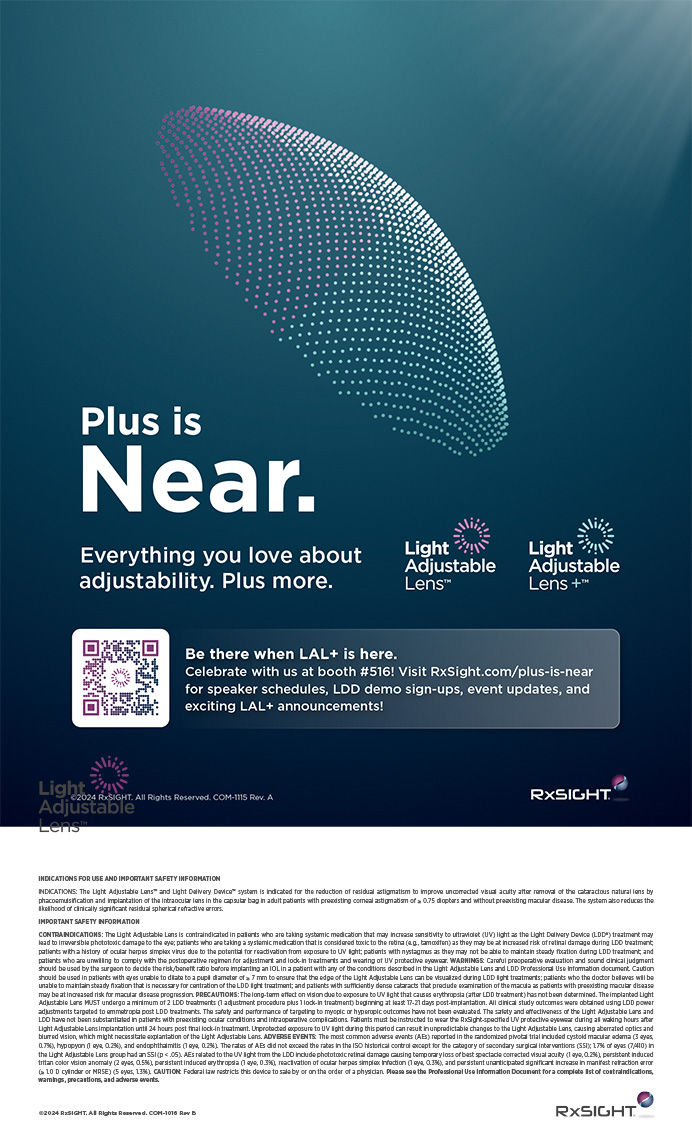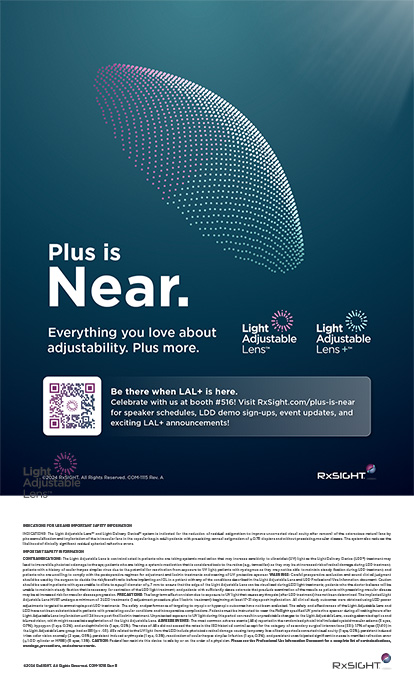Yes, by reducing variability, the technology permits more reproducible results.
By Michael P. Jones, MD
When contemplating this question, it is important to remember that there are two different outcomes to consider: (1) simple surgical success of cataract removal with minimal iatrogenic damage to the eye (corneal edema, iris trauma, vitreous loss, etc.) and (2) the refractive outcome. With that in mind, I would offer the following answer: laser cataract surgery produces consistently better outcomes than a purely manual technique. What I mean by this caveat is that most well-trained surgeons who are using modern phaco equipment can do a phenomenal job of removing a cataract. They can even routinely be close to their refractive target for a subset of patients. What they cannot do is hit those targets every time. By eliminating many refractive variables, the femtosecond laser provides more reproducible results.
OUTCOME No. 1. SIMPLE SURGICAL SUCCESS WITH MINIMAL IATROGENIC DAMAGE
The initial step of cataract surgery, wound construction, may be the most important as far as preventing immediate postoperative complications. Poorly fashioned incisions may require extra hydration to seal (which can lead to postoperative edema), or they may require a suture to close (which can induce astigmatism). Worse yet, subpar architecture can cause incisions not to seal properly, leading to leaks and increasing the risk of infection. With laser assistance, the surgeon can precisely construct a wound that will behave the same way every time. A true triplanar incision is possible. Also, I find that, by having the initial cut-down 50% into the stroma, perpendicular to the cornea, I can create a “shelf” that easily hydrates with minimal fluid to close the wound. These wounds are predictable and reproducible, which helps achieve both outcomes described herein for cataract surgery.
The capsulotomy portion of cataract surgery also benefits greatly from laser assistance. Not only does the device create a perfectly round and centered opening (which improves refractive outcomes), it will even do so in eyes with hypermature, dense, white cataracts in which performing a capsulorhexis may be difficult. Different anatomies or rigidities of the capsule can also create surprises during a manual tear. The laser performs the same way each time. Especially on this step of the surgery, it is the reproducibility that far exceeds manual efforts.
The final area in which the laser improves simple surgical success is in nuclear disassembly. Multiple studies have shown that using the laser greatly reduces phaco time and phaco energy.1,2 This leads to consistently clearer corneas. With newer matrix or cubic patterns, lasers can make dense cataracts behave like soft ones. These devices even make “phaco-less” cataract surgery possible, although the benefits of that have yet to be proven.
OUTCOME No. 2. HITTING REFRACTIVE TARGETS
It is in this second outcome measure that laser cataract surgery outshines a traditional manual procedure. The reasons are many, but most important is that the laser eliminates variables that would normally affect the refractive target.
As I mentioned, laser corneal incisions are predictable and reproducible. That makes it much easier for ophthalmologists to calculate their surgically induced astigmatism, an important variable to factor into IOL power calculations. The vast majority of modern surgeons can make stab incisions, but did they drag the blade a little when removing it? Is the cut really 2.4 mm, or is it 2.6 mm? How many surgeons have ever measured to know for sure? With the laser, the incision is the same every time.
The capsulotomy is a major factor in refractive outcomes due to effective lens position (ELP).3-5 There is simply no way to manually create a capsulorhexis of the same size, shape, and location every time. A smaller capsulorhexis results in a longer ELP, and a larger capsulotomy results in a shorter ELP. A laser will make the capsulotomy consistently every time. In fact, it was a reduction in this variable that made my own refractive outcomes more consistent.
The laser also facilitates astigmatic correction by more consistently performing arcuate cuts. The device uses optical coherence tomography to measure the exact corneal thickness in the location of the arcuate cut. It then performs the cut at the surgeon’s chosen depth (I use 80%). I find the arcuate cuts to be crisp and clean. I do not open them at the time of surgery. In other words, I leave the epithelium intact, which I find leads to less foreign body sensation. I can then titrate the correction if needed after surgery.
By minimizing variables and yielding predictable results, laser assistance has produced better outcomes for me than manual cataract surgery.
Michael P. Jones, MD, is the managing partner of Quantum Vision Centers in St. Louis, Missouri, and Southern Illinois. He is a consultant to and clinical researcher for Alcon. Dr. Jones may be reached at mjones@quantumvisioncenters.com.
- de la Cruz J. A reduction in the femtosecond cataract learning curve: initial resident experience performing cataract surgery with and without femtosecond laser. Paper presented at: XXXI Congress of the ESCRS; October 5-9, 2013; Amsterdam, the Netherlands.
- Nagy ZZ, Takacs A, Filkorn T, Sarayba M. Initial clinical evaluation of an intraocular femtosecond laser in cataract surgery. J Refract Surg. 2009;25:1053-1060.
- Norrby S. Sources of error in intraocular lens power calculation. J Cataract Refract Surg. 2008;34:368-376.
- Hill WE. Does the capsulorrhexis affect refractive outcomes? Cataract & Refractive Surgery Today. October 2007:14(10):89-90.
- Cekiç O, Batman C. The relationship between capsulorhexis size and anterior chamber depth relation. Ophthalmic Surg Lasers. 1999;30(3):185-190. Erratum in: Ophthalmic Surg Lasers. 1999;30(9):714.
The jury is still out.
By Gary N. Wörtz, MD
I believe that femtosecond lasers for cataract surgery are among the most amazing machines engineered in the history of ophthalmology. These systems combine laser technology with advanced imaging such as optical coherence tomography, and the devices perform steps of intraocular surgery with precision that no human hand will ever be able to match. That we surgeons have access to this technology is a credit to brilliant ophthalmologists and biomedical engineers working in the ophthalmic industry.
Femtosecond lasers are exquisite tools for performing cataract surgery, but the question is whether or not they provide better outcomes than a manual technique. My answer is, “The jury is still out.”
MY EXPERIENCE
My experience as an early adopter of laser cataract surgery was neutral. I had no complications whatsoever. My time is valuable, however, and the procedure took me an extra 5 minutes per case on average. Additionally, I felt some cases were a bit more difficult to complete after the laser portion due to induced pupillary constriction. I would have overlooked these points if my refractive results had significantly improved, but that was not the case. Moreover, patients who were paying for laser cataract surgery unavoidably had higher expectations, which meant greater frustration over any residual refractive error.
CHANCE OF VARIABILITY
Trust is a sacred bond between patients and physicians. Likewise, ophthalmologists must be able to trust that the equipment they are using will perform consistently. Using a laser to execute steps of the cataract procedure requires surgeons to believe that the machine will be reliable and will not create unexpected problems. No machine is perfect. Nor is any surgeon. The combination of man and machine can create unforeseen trouble as well as the potential for new and exciting opportunities.
Learning a new technique can put patients at risk of a temporary increase in complications. Each surgeon must weigh the risks and benefits of a technique and draw his or her own conclusions as to its merits.
TORIC IOLs VERSUS LIMBAL RELAXING INCISIONS
Limbal or corneal relaxing incisions can be a safe and effective tool for correcting low levels of astigmatism, and the femtosecond laser platforms have allowed for a much more standardized and sophisticated approach to this modality. In my opinion, however, toric IOLs are a better tool for correcting astigmatism, especially for cylinder above 1.50 D. The cornea is a dynamic structure and prone to variability of effect, surgically induced irregular astigmatism, and regression and progression of the astigmatic correction after incisional surgery. A toric IOL, on the other hand, is unchanging and provides a consistent correction over time.
Further study is needed on the long-term results of laser arcuate incisions versus toric IOLs. In my hands, however, a toric IOL currently has a much better success rate.
FUNDAMENTALS
Why is laser cataract surgery not better than a traditional approach quite yet? The fundamentals of the procedure have not changed.
In recent memory, only the Nd:YAG laser, excimer laser, and phaco units have altered the basics of an ophthalmic procedure. Although the femtosecond laser has certainly added to our armamentarium, we ophthalmologists still make a 2- to 3-mm incision and a capsulotomy. We continue to subdivide the lens and vacuum it out, and we still implant an IOL. Granted, we are typically using less phaco energy during cataract removal, and that could make a difference for patients with Fuchs corneal dystrophy or extremely dense lenses. Regardless, laser cataract surgery is simply a different and more automated way of executing the same steps. Because the fundamentals of the cataract procedure have not really changed, the outcomes are unlikely to change, either, especially when refractive results have never hinged on surgical technique for the most part.
In my opinion, the effective lens position (ELP) is the single most important barrier to successful outcomes. I find it interesting that, despite the early talking points of a more predictable ELP with laser cataract surgery, outcomes have not seemed to improve yet. Without a better way of predicting the ELP, we will always be hamstrung in our ability to hit our refractive goals.
If and when IOL technology catches up to the laser’s ability to create a perfectly round capsulorhexis that is centered on the visual axis, the value of the laser system may change altogether. Perhaps advances in laser technology have put the cart before the horse. In this case, a new lens design may be the horse we are awaiting.
Ophthalmic surgeons are a talented group of individuals who will be hard, if not impossible, for any technology to replace. As a rule, we love innovation, but we may be reticent to embrace it early in its lifespan. Laser cataract surgery is likely here to stay, so our best efforts might be applied to developing the other innovations that will take this technology and our results to a whole new level.
Gary N. Wörtz, MD, is chief medical officer of Omega Ophthalmics, and he is CEO and founder of Bluegrass Eye Surgery in Central Kentucky. Dr. Wörtz may be reached at (859) 231-0430; garwortzmd@gmail.com.


